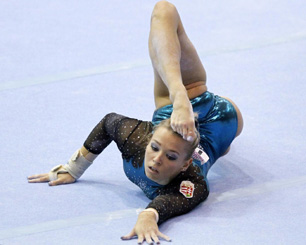Artistic Gymnastics
Updated: 2012-05-14 17:45
(london2012.com)
|
||||||||
The grace, strength and skill of Olympic gymnasts have been astonishing audiences since the Games in Ancient Greece, where Gymnastics was regarded as the perfect symmetry between mind and body. The best known of the three Gymnastics disciplines, Artistic Gymnastics is always among the most popular competitions at the Games.
 |
|
[Photo/Agencies] |
Competition dates:
July 28 – Aug 7
Competition venue:
North Greenwich Arena
Number of medal events:
14–men's individual apparatus (Floor, Pommel Horse, Rings, Vault, Parallel Bars, Horizontal Bar), women's individual apparatus (Vault, Uneven Bars, Balance Beam, Floor), as well as Individual All-Around and Team competitions for both men and women.
Number of competitors:
196: 98 men and 98 women
Each country is limited to five men and five women
History of Gymnastics at the Olympic Games
The term Artistic Gymnastics was first used in the 19th century. Between its appearance at the Athens 1896 Games and the 1920s, the event evolved into what we recognise as modern Gymnastics. The men's individual apparatus and Team competitions first appeared at the Paris 1924 Games; a women's Team event was introduced in 1928, with women's individual apparatus competitions added in 1952.
The basics
Along with events to find the best teams and the best all-around performers, gymnasts battle for gold on individual apparatus.
Scores are given by a panel of judges, taking into account the degree of difficulty and the quality of the execution. Strength, flexibility and balance are keys to success in this breathtaking and hugely competitive sport.
Competition format
The Olympic Artistic Gymnastics competition has four phases: qualification, Team final, Individual All-Around final and individual apparatus finals.
All gymnasts compete in the qualifications. The best eight teams then go through to the Team final, where three team members compete on each apparatus. Teams are ranked on their total score.
The best 24 individual gymnasts (maximum two from each country) go through to the Individual All-Around final, where gymnasts compete on all apparatus. The best eight gymnasts on each apparatus (maximum two from each country) go through to the individual apparatus finals.
Each apparatus is judged for difficulty and execution, with the highest scoring athlete the winner.
Officials
The jury is made up of nine judges, who look at difficulty and execution, deducting marks for penalties.
Keys to success
Although they make it look effortless, gymnasts need incredible strength, control and balance, combined with speed in the Vault. The winning gymnasts will be daring and ambitious – attempting moves that are guaranteed a high score for difficulty if they can be executed to perfection.
Judged against such exacting criteria, the smallest extra step, wobble, misalignment or mistake in a routine can make all the difference. Gymnasts must not lose concentration for a moment.
Jargon buster
All-around – competitions that feature a variety of different elements (six for men, four for women).
Balance Beam – a single beam, 5m long and 10cm wide, used exclusively in women's competition.
Rings – two rings, each with an internal diameter of 18cm, are suspended 280cm from the floor. Rings are used exclusively in men's competition.
Podium – the raised competition area.
Vault – the vault is 120cm long and 95cm wide, and is set at a height of 135cm (for men) or 125cm (for women).

 'Taken 2' grabs movie box office crown
'Taken 2' grabs movie box office crown
 Rihanna's 'Diamonds' tops UK pop chart
Rihanna's 'Diamonds' tops UK pop chart
 Fans get look at vintage Rolling Stones
Fans get look at vintage Rolling Stones
 Celebrities attend Power of Women event
Celebrities attend Power of Women event
 Ang Lee breaks 'every rule' to make unlikely new Life of Pi film
Ang Lee breaks 'every rule' to make unlikely new Life of Pi film
 Rihanna almost thrown out of nightclub
Rihanna almost thrown out of nightclub
 'Dark Knight' wins weekend box office
'Dark Knight' wins weekend box office
 'Total Recall' stars gather in Beverly Hills
'Total Recall' stars gather in Beverly Hills
Most Viewed
Editor's Picks

|

|

|

|

|

|
Today's Top News
Health new priority for quake zone
Xi meets US top military officer
Japan's boats driven out of Diaoyu
China mulls online shopping legislation
Bird flu death toll rises to 22
Putin appoints new ambassador to China
Japanese ships blocked from Diaoyu Islands
Inspired by Guan, more Chinese pick up golf
US Weekly

|

|






